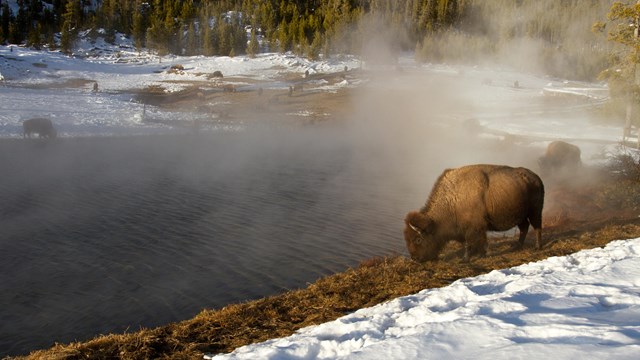
NPS Managing Resources and Impacts Across Political LinesDespite the size of the ecosystem, Greater Yellowstone’s biodiversity is not guaranteed. Many of its plant and animal species are rare, threatened, endangered, or of special concern, including more than 100 plants, hundreds of invertebrates, six fish species, several amphibian species, at least 20 bird species, and 18 mammal species. These are estimates because comprehensive inventories have not been completed. A healthy Yellowstone is important for meeting the park's mandate to preserve resources and values in a manner that provides for their enjoyment by people. At the same time, a healthy Yellowstone enhances the lives of people living outside the park by providing sustainable resources such as clean water, wildlife populations, and vegetation communities. Several factors strongly influence the Greater Yellowstone Ecosystem and its management:
Ecosystem managers face these challenges by addressing the whole ecosystem, including preserving individual components and their relationships and linkages between them. Maintaining healthy, functioning ecosystems preserves species more effectively than do emergency measures to bring back threatened species from the brink of extinction. PartnersEffective management also requires strong partnerships. Several management and research partnerships exist among state, federal, and tribal agencies to help focus resources and provide collaborative problem solving on regional issues. Many of these partnerships include academic and non-profit institutions as well. Greater Yellowstone NetworkThe Greater Yellowstone Network (GRYN) was established by the National Park Service Inventory and Monitoring Program in 2000 to help enhance the scientific basis for stewardship and management of natural resources in Bighorn Canyon National Recreation Area, Grand Teton National Park (including John D. Rockefeller, Jr. Memorial Parkway), and Yellowstone National Park. The GRYN is one of 32 units nationwide that group some 270 national parks into networks based on geographic similarities, common natural resources, and resource protection challenges. This collective approach to inventory and monitoring helps to facilitate collaboration and information sharing between the parks and with other natural-resource management agencies and interests. Rocky Mountains Cooperative Ecosystem Studies UnitThe Rocky Mountains Cooperative Ecosystem Studies Unit brings together the region’s best scientific talent and scholarship to help manage resource problems across social, cultural, economic, political, and environmental arenas. The Rocky Mountains Cooperative Ecosystem Studies Unit conducts research, education, and technical assistance on both agency-specific issues and on issues concerning areas of mixed ownership. This information is made available to those who need it, including land managers and political and industry leaders. Greater Yellowstone Coordinating CommitteeIn 1964, the managers of the national parks and national forests in the Greater Yellowstone Ecosystem formed the Greater Yellowstone Coordinating Committee (GYCC) to seek solutions to common issues. One of the nation’s earliest land-management partnerships, the GYCC first signed a Memorandum of Understanding in 1964. The GYCC now includes managers from two national parks, five national forests, two national wildlife refuges, the Bureau of Land Management in Montana, Idaho, and Wyoming, and the fish and wildlife departments of Wyoming, Montana, and Idaho. During its six decades, the GYCC has provided a forum for information exchange and voluntary cooperation between key agencies for managing the GYE. The GYCC managers set priorities for interagency coordination and allocate staff and funding to advance these priorities. Interagency staff and partners collaborate on topic-specific subcommittees to address priority issues and to coordinate operations such as wildfire management. GYCC subcommittees include: clean air partnership, hydrology, wildlife, native fish, terrestrial invasive species, aquatic invasive species, whitebark pine, wildland fire management, and climate change adaptation. GYCC priorities are: 1. Maintain Resilient Landscapes within the Greater Yellowstone Ecosystem
2. Respond to Increased Visitor Use
3. Strengthen Coalitions, Partnerships, and Communications
Source: NPS DataStore Saved Search 3626. To search for additional information, visit the NPS DataStore. 
Fire Management
Balancing the benefits and threats of fire. 
Bioprospecting
Bioprospecting is the discovery of useful scientific information from genetic or biochemical resources. 
Greater Yellowstone Ecosystem
Yellowstone is the heart of one of the largest, nearly intact temperate-zones on Earth. |
Last updated: April 18, 2025
